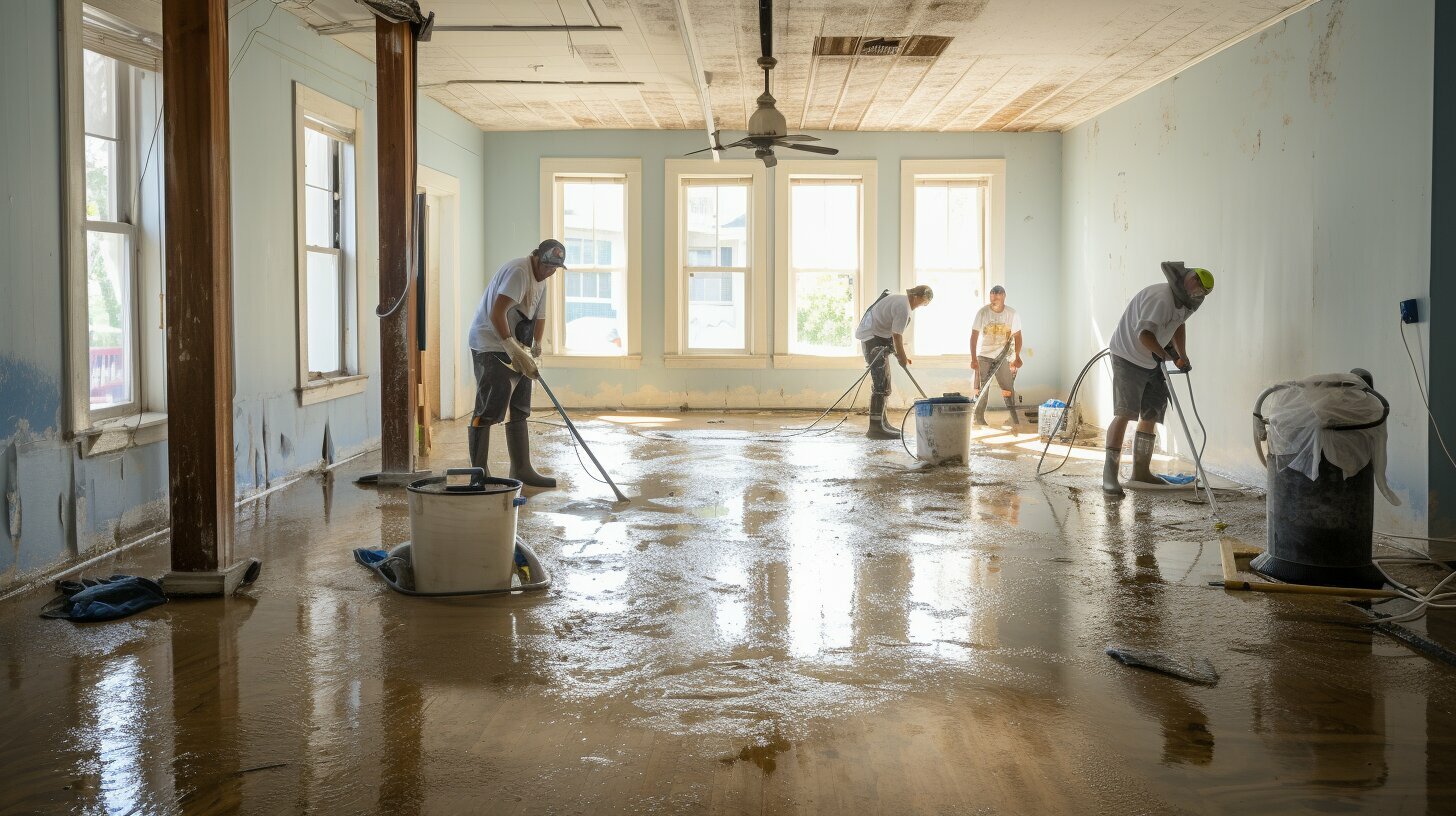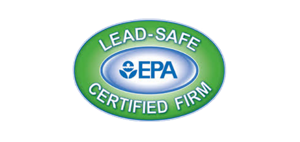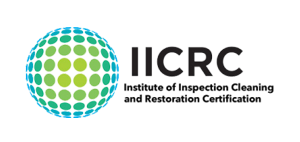Dealing with mold growth after a flood is crucial to ensure a safe and mold-free environment. By taking the right preventive measures, you can effectively tackle post-flood mold problems and protect your property.
To prevent mold after a flood, it is important to control moisture and dry the affected area as quickly as possible. Here are some steps to prevent mold growth:
- Open up the building during the day to let humid air out, and close it up overnight.
- Remove all debris and wet items, including porous or absorbent materials.
- Clean exposed surfaces with disinfectants or sanitizers, and thoroughly dry them.
- Remove saturated carpeting or use a carpet extractor or wet/dry vacuum to remove water.
- Use fans to circulate air and speed up evaporation, unless mold has already started growing.
- Use dehumidifiers to reduce air moisture content, especially in closed areas.
Running a dehumidifier until all porous surfaces are dry is recommended. It can take anywhere from two days to several weeks to completely dry a flood-damaged building. It is important to keep humidity levels below 50 percent to discourage mold growth.
To kill mold after a flood, common household items like bleach, dish detergent, and commercial mold and mildew removers can be used. It is important to follow safety precautions and use protective equipment when cleaning with these substances. You might want to use a mold test kit to see if you have mold in the air.
In some cases, it may be necessary to consult a professional mold remediation company, especially if the mold growth covers more than 10 square feet or there has been significant water damage.
Other general safety precautions after a flood include wearing protective gear, not mixing bleach or ammonia with other cleaners, and having the HVAC system checked and cleaned before turning it on.
Signs of a mold problem include musty smells, warping or peeling materials, color lightening with bleach, and the presence of moisture without much light nearby.
Key Takeaways:
- Control moisture and dry the affected area quickly after a flood to prevent mold growth.
- Remove debris and wet items, and thoroughly clean exposed surfaces with disinfectants.
- Use fans and dehumidifiers to circulate air and reduce air moisture content.
- Consult a professional mold remediation company for large mold growth or significant water damage.
- Wear protective gear, avoid mixing bleach or ammonia with other cleaners, and have the HVAC system checked before use.
By following these preventive measures and taking prompt action, you can effectively prevent mold growth and maintain a healthy environment after a flood.
Steps to prevent mold after a flood
To prevent mold from taking hold after a flood, it is crucial to follow these essential steps:
- Open up the building during the day to let humid air out, and close it up overnight.
- Remove all debris and wet items, including porous or absorbent materials.
- Clean exposed surfaces with disinfectants or sanitizers, and thoroughly dry them.
- Remove saturated carpeting or use a carpet extractor or wet/dry vacuum to remove water.
- Use fans to circulate air and speed up evaporation, unless mold has already started growing.
- Use dehumidifiers to reduce air moisture content, especially in closed areas.
Running a dehumidifier until all porous surfaces are dry is recommended. It can take anywhere from two days to several weeks to completely dry a flood-damaged building. It is important to keep humidity levels below 50 percent to discourage mold growth.
To kill mold after a flood, common household items like bleach, dish detergent, and commercial mold and mildew removers can be used. It is important to follow safety precautions and use protective equipment when cleaning with these substances.
In some cases, it may be necessary to consult a professional mold remediation company, especially if the mold growth covers more than 10 square feet or there has been significant water damage.
Other general safety precautions after a flood include wearing protective gear, not mixing bleach or ammonia with other cleaners, and having the HVAC system checked and cleaned before turning it on.
Signs of a mold problem include musty smells, warping or peeling materials, color lightening with bleach, and the presence of moisture without much light nearby.
Taking prompt action to control moisture and dry the affected area, along with proper cleaning and disinfection, can help prevent mold growth and protect against health hazards.
Seeking Professional Help and General Safety Precautions
While these preventive measures can go a long way in preventing mold growth, there are situations where professional assistance is necessary. In cases where the mold growth covers more than 10 square feet or significant water damage has occurred, it is important to consult a professional mold remediation company. These experts have the knowledge, tools, and experience to handle large-scale mold removal safely and effectively.
When dealing with mold after a flood, it is crucial to take general safety precautions to protect yourself and your property. Always wear appropriate protective gear, such as gloves, goggles, and a mask, to avoid direct contact with mold spores and the chemicals used for cleaning. It is also important to avoid mixing bleach or ammonia with other cleaners, as this can produce toxic fumes.
Before turning on your HVAC system, have it checked and cleaned by a professional. Moisture from a flood can cause mold to grow in the system, which can then spread throughout your home. Having it inspected and cleaned will help ensure that clean, mold-free air is circulating.
Keep an eye out for common signs of a mold problem, including musty smells, warping or peeling materials, color lightening with bleach, and the presence of moisture without much light nearby. If you notice any of these signs, it is important to take immediate action to address the mold issue and prevent further damage to your property and potential health hazards.
| General Safety Precautions After a Flood: |
|---|
| Wear protective gear (gloves, goggles, mask) when dealing with mold. |
| Avoid mixing bleach or ammonia with other cleaners to prevent toxic fumes. |
| Have the HVAC system checked and cleaned before turning it on. |
| Inspect for signs of mold, such as musty smells or warping materials. |
Conclusion
Taking prompt action to control moisture, dry the affected area, and follow proper cleaning and disinfection procedures is crucial in preventing mold growth and safeguarding against potential health hazards.
To prevent mold after a flood, it is important to open up the building during the day to let humid air out and close it up overnight. Removing all debris and wet items, including porous or absorbent materials, is essential. Cleaning exposed surfaces with disinfectants or sanitizers, and thoroughly drying them, is also necessary.
Additionally, removing saturated carpeting or using a carpet extractor or wet/dry vacuum to remove water can help prevent mold growth. Using fans to circulate air and speed up evaporation, unless mold has already started growing, is recommended. Utilizing dehumidifiers in closed areas to reduce air moisture content is also effective in preventing mold after a flood.
Running a dehumidifier until all porous surfaces are dry is recommended. It can take anywhere from two days to several weeks to completely dry a flood-damaged building. It is important to keep humidity levels below 50 percent to discourage mold growth.
To kill mold after a flood, common household items like bleach, dish detergent, and commercial mold and mildew removers can be used. However, it is crucial to follow safety precautions and use protective equipment when cleaning with these substances.
In some cases, it may be necessary to consult a professional mold remediation company, especially if the mold growth covers more than 10 square feet or there has been significant water damage.
Other general safety precautions after a flood include wearing protective gear, not mixing bleach or ammonia with other cleaners, and having the HVAC system checked and cleaned before turning it on.
Signs of a mold problem include musty smells, warping or peeling materials, color lightening with bleach, and the presence of moisture without much light nearby.
Taking prompt action to control moisture and dry the affected area, along with proper cleaning and disinfection, can help prevent mold growth and protect against health hazards.
FAQ
How do you prevent mold after a flood?
To prevent mold after a flood, it is important to control moisture and dry the affected area as quickly as possible. Here are some steps to prevent mold growth:
What are the steps to prevent mold after a flood?
The steps to prevent mold after a flood include:
- Opening up the building during the day to let humid air out, and closing it up overnight.
- Removing all debris and wet items, including porous or absorbent materials.
- Cleaning exposed surfaces with disinfectants or sanitizers, and thoroughly drying them.
- Removing saturated carpeting or using a carpet extractor or wet/dry vacuum to remove water.
- Using fans to circulate air and speed up evaporation, unless mold has already started growing.
- Using dehumidifiers to reduce air moisture content, especially in closed areas.
When should I seek professional help and what are the general safety precautions after a flood?
It may be necessary to consult a professional mold remediation company if the mold growth covers more than 10 square feet or there has been significant water damage. Other general safety precautions after a flood include wearing protective gear, not mixing bleach or ammonia with other cleaners, and having the HVAC system checked and cleaned before turning it on.
What are the signs of a mold problem?
Signs of a mold problem include musty smells, warping or peeling materials, color lightening with bleach, and the presence of moisture without much light nearby.
Why is it important to take immediate action to prevent mold after a flood?
Taking prompt action to control moisture and dry the affected area, along with proper cleaning and disinfection, can help prevent mold growth and protect against health hazards.









